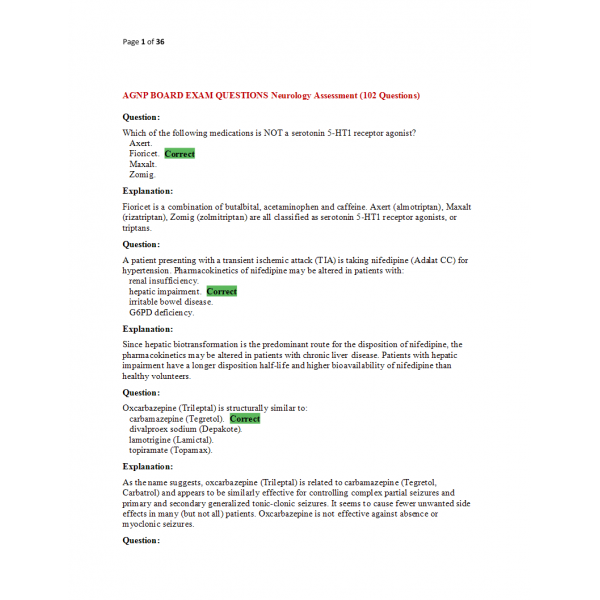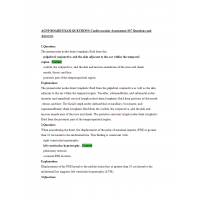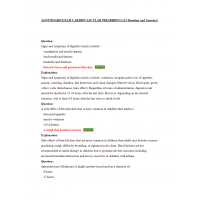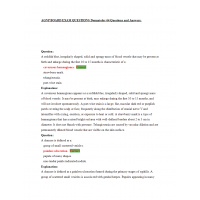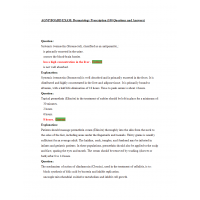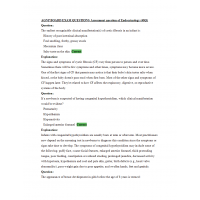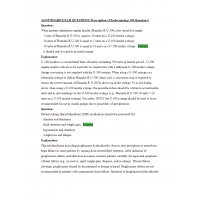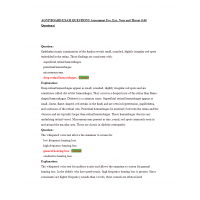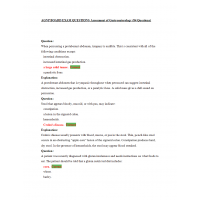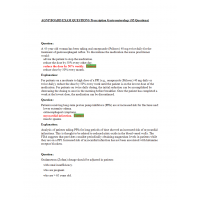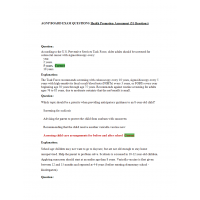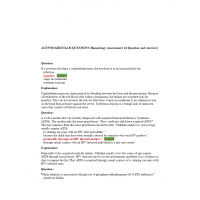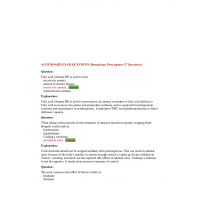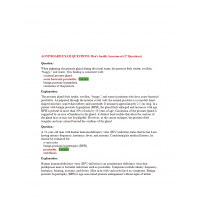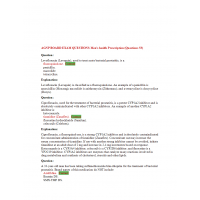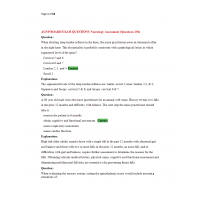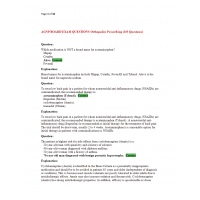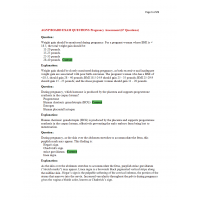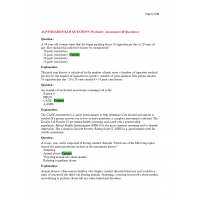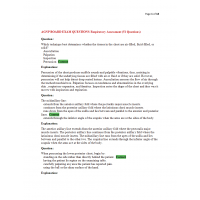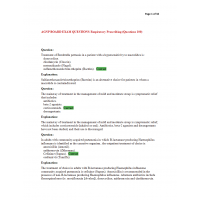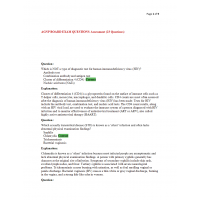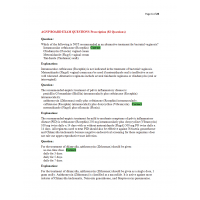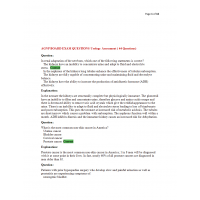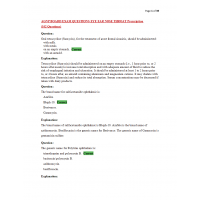AGNP BOARD EXAM QUESTIONS Neurology Assessment (102 Questions)
1. Which of the following medications is NOT a serotonin 5-HT1 receptor agonist?
2. A patient presenting with a transient ischemic attack (TIA) is taking nifedipine (Adalat CC) for hypertension. Pharmacokinetics of nifedipine may be altered in patients with:
3. Oxcarbazepine (Trileptal) is structurally similar to:
4. Patients who experience greater than 7 to 9 tension-type headaches per month may be considered for maintenance therapy including:
5. Beta-blockers, used for the prophylactic treatment of migraines, would NOT be contraindicated in a patient with a history of:
6. Patients who are taking carbidopa/levodopa (Sinemet) for Parkinson's disease should be advised to avoid a diet high in:
7. Which of the following statements is NOT true about antiepileptic drugs (AEDs)
8. Patients who are taking divalproex sodium (Depakote) and lamotrigine (Lamictal) are at higher risk for developing
9. Children who are receiving gabapentin (Neurontin) should be monitored for:
10. During initiation of treatment and escalation of doses, pramipexole (Mirapex) and other dopamine agonists are known to cause:
11. Sumatriptan (Imitrex), a serotonin (5-HT1) receptor agonist, is:
12. Patients who require oral corticosteroids for the treatment of Bell's Palsy should be instructed to take the medication:
13. To be of greatest benefit, corticosteroids in the treatment of Bell's palsy should be initiated within:
14. Beta-blockers are contraindicated in patients with
15. Ropinirole (Requip), used in the treatment of restless legs syndrome (RLS), is metabolized primarily in the:
16. Which of the following medications is an N-methyl-D-aspartate receptor antagonist for the treatment of dementia of the Alzheimer's type?
17. The most common short-term adverse effects of ropinirole (Requip) used in restless leg syndrome (RLS) include:
18. Carbidopa/levodopa (Sinemet) for the treatment of Parkinson's disease is contraindicated in patients with:
19. Pramipexole (Mirapex), a dopamine agonist, is indicated in the treatment of:
20. Exercise caution before initiating pregabalin (Lyrica) in combination with:
21. The first-line treatment in acute tension-type headache i
22. Triptans, such as sumatriptan (Imitrex), should NOT be administered concomitantly with:
23. The brand name of oxcarbazepine is:
24. The first-line pharmacological option for the treatment of generalized tonic-clonic seizures is:
25. The most common side effects related to benztropine (Cogentin) and trihexyphenidyl, used in the treatment of parkinsonism, are:
26. Education for patients who are taking amantadine should NOT include:
27. The generic name for Depakote is:
28. The primary beta-blocker indicated for the prophylactic treatment of migraine headaches is
29. A patient who is receiving divalproex sodium (Depakote) reports acute abdominal pain accompanied by nausea and vomiting. This patient should be evaluated for:
30. At each follow-up visit for patients who are taking carbidopa/levodopa (Sinemet), the provider should specifically inquire about
31. A patient who is taking beta-blockers for the prophylactic treatment of migraine headache does NOT need to be monitored for:
32. Macrolides, such as clarithromycin (Biaxin), are NOT generally used to treat:
33. Amantadine, an antiviral agent and an N-methyl-D-aspartate (NMDA) receptor antagonist, is indicated in the treatment of:
34. A pediatric patient who is taking valproic acid (Depakene) may exhibit toxicity symptoms which would include:
35. Phenobarbital, indicated for the treatment of epilepsy, is:
36. Divalproex sodium (Depakote) for the prophylactic treatment of migraines
37. The brand name for levetiracetam is
38. Pregabalin (Lyrica) is NOT approved for the treatment of:
39. The mechanism of action of pramipexole (Mirapex) is to:
40. Patients receiving non-cardioselective beta blockers for migraine treatment are much more likely to experience:
41. Levetiracetam (Keppra), indicated in the adjunctive treatment of partial seizures, is:
42. Oral levetiracetam (Keppra) is indicated for use as:
43. Carbidopa/levodopa (Sinemet) for the treatment of Parkinson's disease is a(n):
44. The most common reason patients discontinue use of pregabalin (Lyrica) is
45. Ergotamine alkaloids, such as dihydroergotamine (Migranal), are indicated in the treatment of:
46. Patients taking topiramate (Topamax) are at high risk for developing:
47. A patient was started on lamotrigine (Lamictal) 4 weeks ago, and today presents with a mild rash on the upper left thigh. The nurse practitioner should:
48. Carbamazepine (Tegretol), used in the treatment of trigeminal neuralgia,:
49. For treatment of Bell's palsy, combination therapy is considered to be more beneficial and includes corticosteroids plus:
50. The medication recommended for the rescue of refractory or cluster seizure activity is:
51. To prevent further events, patients with transient ischemic attacks (TIAs) should be treated with
52. A patient who is taking valproic acid (Depakote) should have routine laboratory monitoring which includes a:
53. Serotonin (5HT1) receptor agonists, or triptans:
54. Primidone (Mysoline) is metabolized into two active metabolites, one of which is:
55. The brand name for carbamazepine is
56. A drug interaction may occur between carbamazepine (Tegretol) and:
57. The brand name of phenytoin sodium is
58. The patient who requires the LEAST cautionary measures when treated with carbidopa/levodopa (Sinemet) is:
59. Ergotamine alkaloids for the treatment of migraines are safe to administer with:
60. Taking a triptan (5-HT1 agonist), such as sumatriptan (Imitrex), early in the headache cycle does NOT:
61. Carbidopa and levodopa are the active ingredients in Sinemet used to treat Parkinson's disease. The addition of carbidopa:
62. Which medication may be beneficial in the treatment of restless legs syndrome (RLS)?
63. Ticlopidine (Ticlid), a platelet aggregation inhibitor,
64. Butalbital, one of the components of Fioricet, a medication used to abort tension-type headaches:
65. Acetaminophen may be used to reduce fever in the presence of a febrile seizure. A severe complication of acetaminophen (Tylenol) is:
66. Acute tension-type headaches refractory to simple analgesics may respond to a combination of analgesics and
67. Which medication does NOT have an indication for the treatment of Parkinson disease?
68. The medication class that does NOT lead to postural hypotension and possible syncope is:
69. After initiation of 300 mg serum phenytoin (Dilantin), daily levels should be checked at approximately:
70. The generic name for Lyrica is
71. Non-selective beta-blockers used in migraine prophylaxis actively compete for beta receptors, inhibiting the binding of
72. Benztropine (Cogentin), an anticholinergic, is NOT recommended for use in patients with
73. A patient who is taking carbamazepine (Tegretol) for trigeminal neuralgia presents with complaints of fatigue, muscle cramps and nausea. These are symptoms of:
74. Chronic use of phenytoin (Dilantin) has been associated with:
75. Sumatriptan (Imitrex) is classified as a(n):
76. Due to increased cholinergic activity in patients treated with donepezil (Aricept), patients should be monitored for:
77. Patients who are taking rasagiline (Azilect) for the treatment of Parkinson's disease should avoid other CYP1A2 inhibitors such as:
78. Patients receiving oxcarbazepine (Trileptal) should be routinely monitored for:
79. Fioricet, indicated for the abortive treatment of tension-type headache, is a combination of acetaminophen,:
80. Which of the following is a non-dihydropyridine calcium channel blocker?
81. Monitoring for side effects of topiramate (Topamax) includes:
82. Patients with mild chronic obstructive pulmonary disease may receive a beta-blocker for migraine prophylaxis as long as they are not currently taking a(n)
83. Propranolol hydrochloride (Inderal) for the treatment of migraines
84. A patient receiving lamotrigine (Lamictal) for the treatment of epilepsy would NOT need routine monitoring of:
85. In addition to the treatment of various forms of epilepsy, lamotrigine (Lamictal) is indicated in the treatment of:
86. Syncope related to vasovagal symptoms is best treated with:
87. Common side effects related to pregabalin (Lyrica) include:
88. Clopidogrel (Plavix) is considered
89. Clindamycin (Cleocin) is NOT indicated in the treatment of:
90. Which medication is approved for prophylactic treatment of migraine headaches
91. Following an acute overdose of acetaminophen (Tylenol), patients who are at significant risk for hepatotoxicity should receive:
92. Monitoring of patients receiving gabapentin (Neurontin) should include:
93. Medications with significant anticholinergic properties, such as amantadine (Symmetrel) to treat Parkinson's disease, block which neurotransmitter?
94. Donepezil (Aricept), a cholinesterase inhibitor, is indicated in the treatment of
95. The pharmacological management that provides the greatest clinical improvement of carpal tunnel syndrome is:
96. Carbamazepine (Tegretol) is indicated in the treatment of:
97. Divalproex sodium (Depakote) for the treatment of epilepsy can be safely administered to
98. A medication used in a patient with a transient ischemic attack to prevent platelet aggregation and produce an anti-inflammatory effect in vessels by inhibiting prostaglandin synthesis is:
99. Topiramate (Topamax), an antiepileptic drug,:
100. The LEAST important goal of pharmacologic therapy in the treatment of epilepsy is to:
101. A common adverse reaction to clopidogrel (Plavix) is:
102. Patients receiving levetiracetam (Keppra) are NOT likely to experience the side effect of:
| Institution & Term/Date | |
| Term/Date | AGNP Exam |
AGNP Board Exam Question and Answers - Neurology Prescribing
- Product Code: 2020
- Availability: In Stock
-
$45.00

